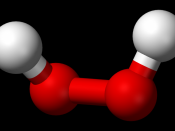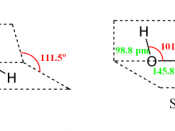P
LANNING
Aim:
Our aim is to detect which factors affect the rate of the decomposition of hydrogen peroxide with a fixed mass of catalyst. A catalyst is a substance, which alters the speed, or rate of a chemical reaction but is chemically unchanged at the end of the reaction. The two factors that we can change are the temperature and the concentration.
We chose to vary the concentration of hydrogen peroxide. The catalyst to speed up the reaction without affecting the result will be manganese oxide.
Prediction:
I predict that the higher the concentration of hydrogen peroxide, the faster hydrogen peroxide and manganese oxide decomposes. Therefore the lower the concentration of hydrogen peroxide, the lower the rate that hydrogen peroxide and manganese oxide decompose.
The prediction we have just made has been based on the collision theory-'Chemical reactions occur when particles of the reactant collide with enough energy' (John Holman page 225).
If the concentration of the solution is high then there is more chance of the particles colliding. This is because if the concentration increases then so does the number of particles. The more particles there are, the greater the chance of the particles colliding so therefore that gives reason to believe that the rate of the reaction increases.
Pre-test
During our pre-test lesson we needed to find the ideal mass of catalyst. We began with 1g of manganese oxide, which we weighed on a top-pan balance and added it to 100cm" of hydrogen peroxide. We used 100% concentration because we thought that to ensure our catalyst mass was suitable we needed to see what the most reactant experiment would be like. However, 1g of manganese oxide seemed to be too much as the amount of gas was produced too quickly and we were unable to record any...


